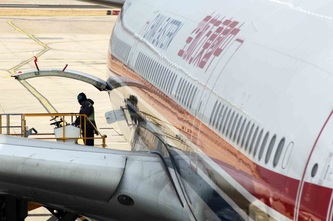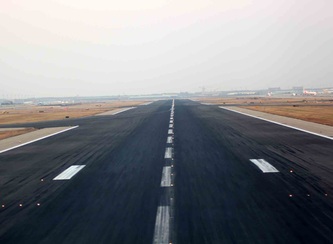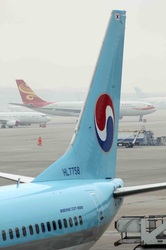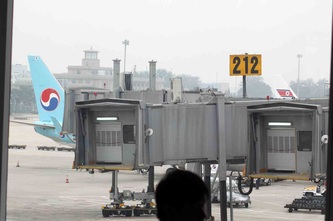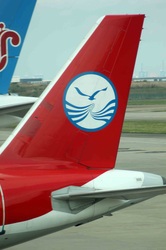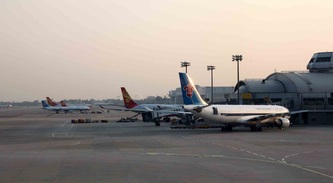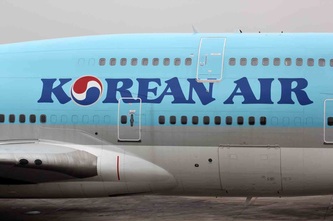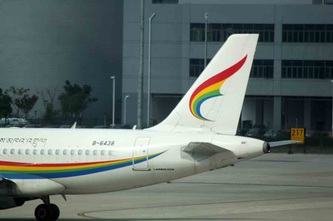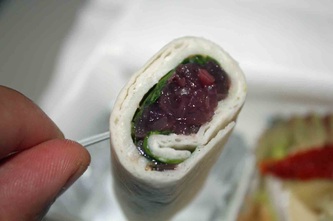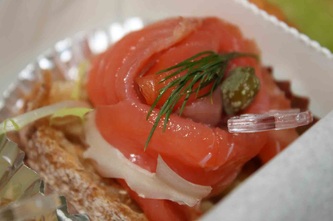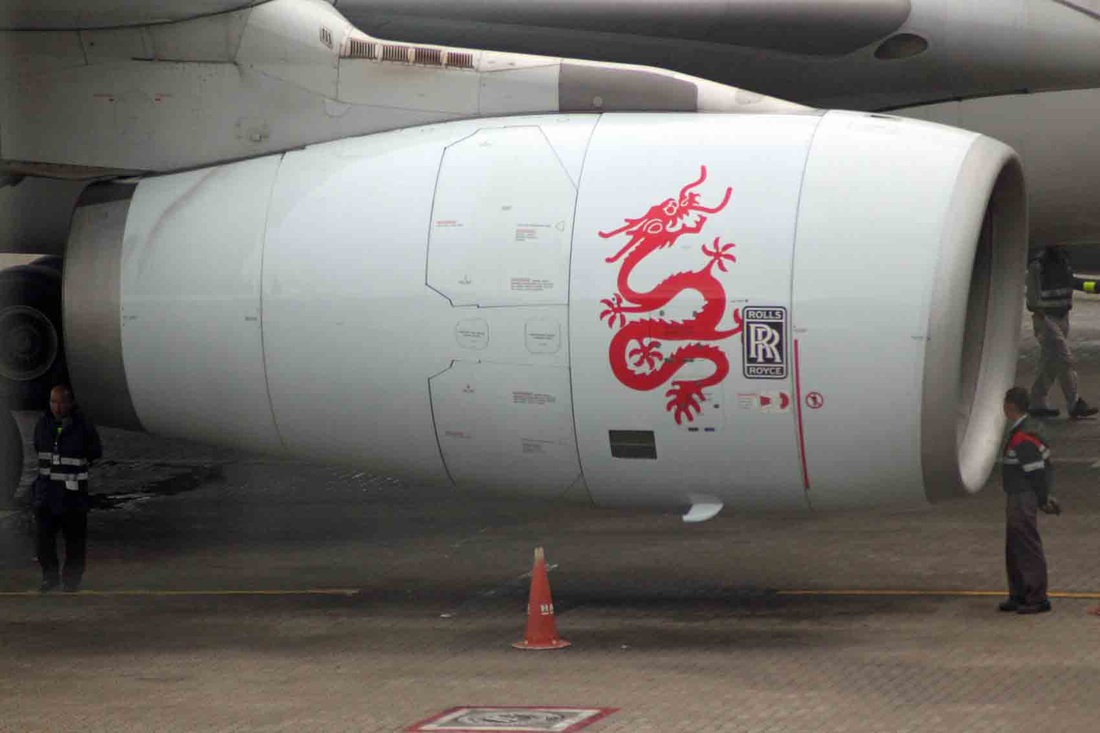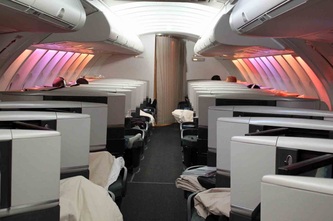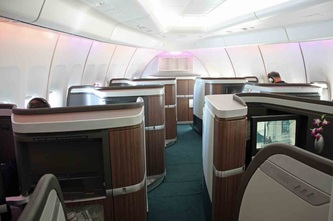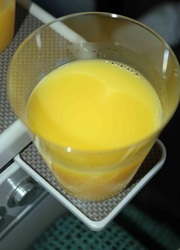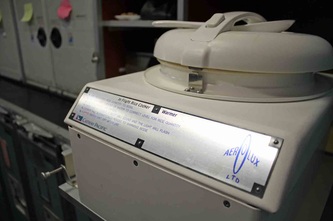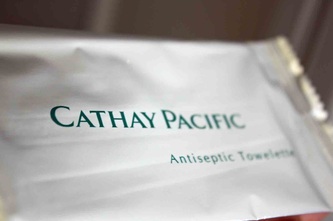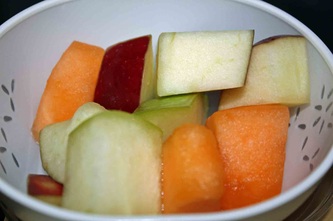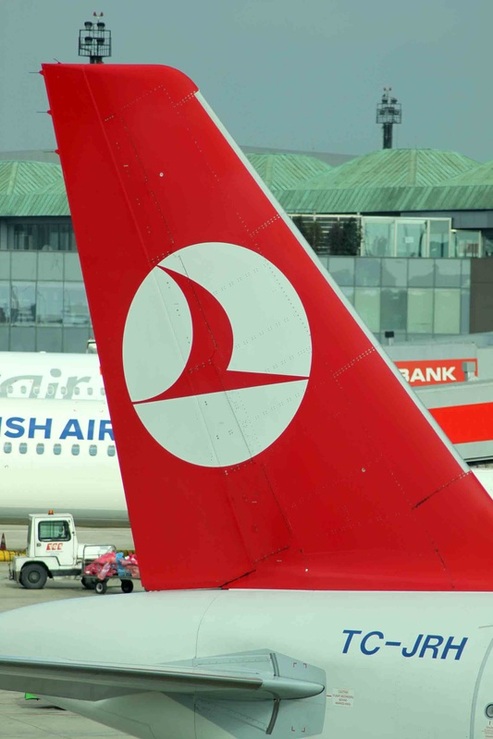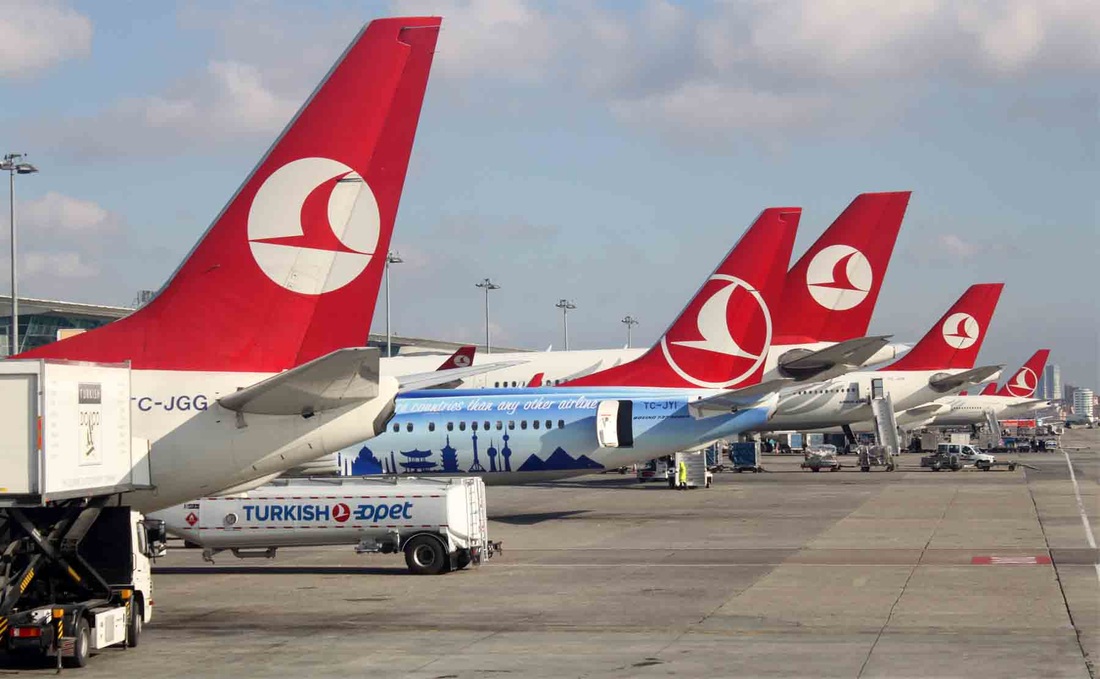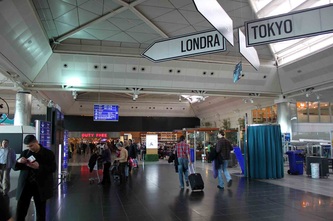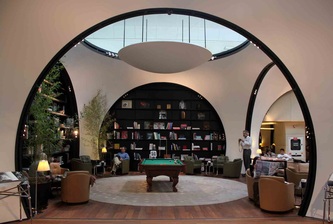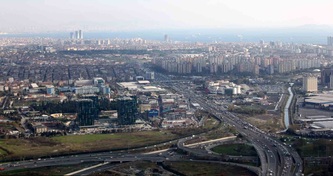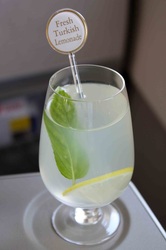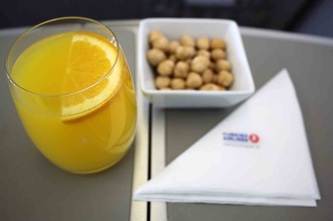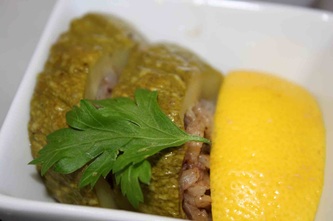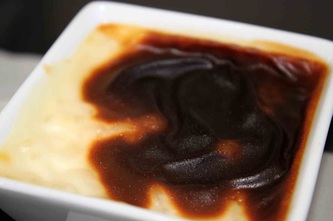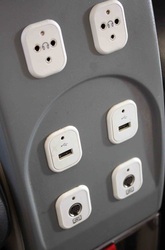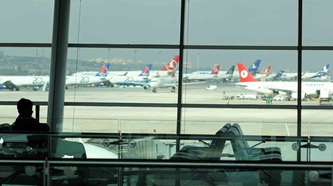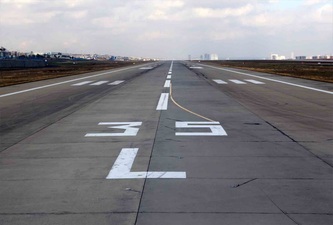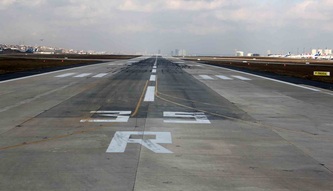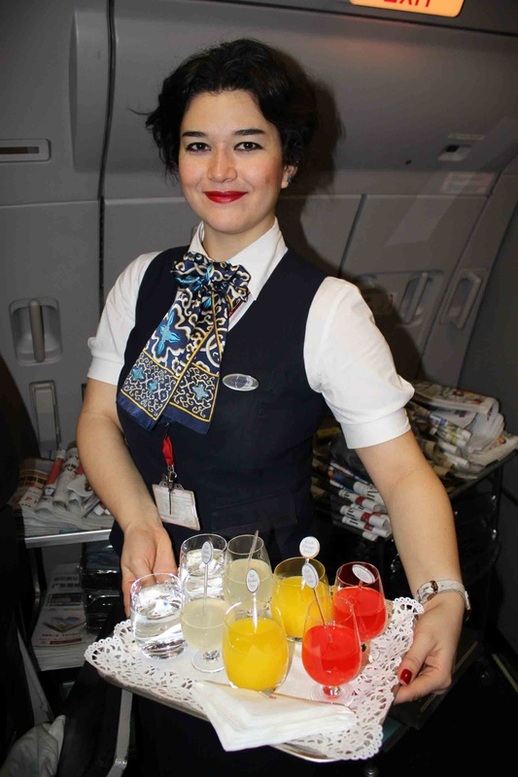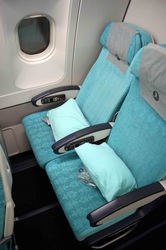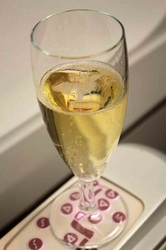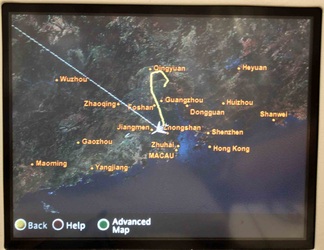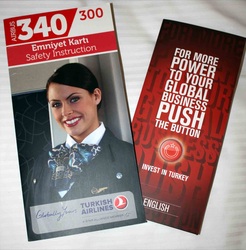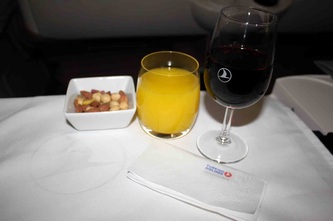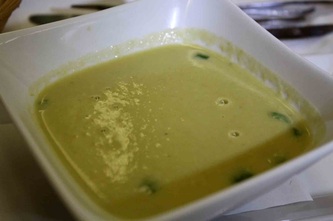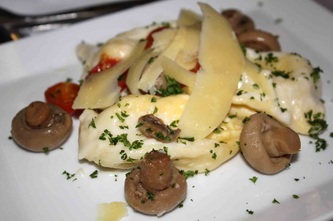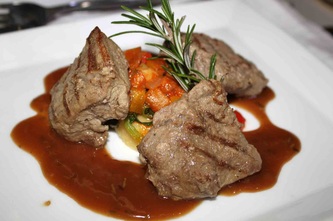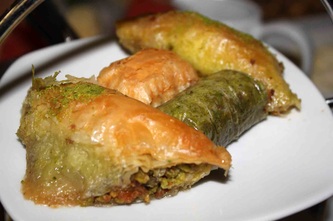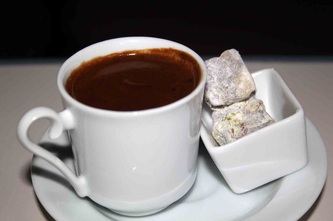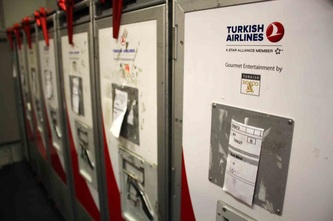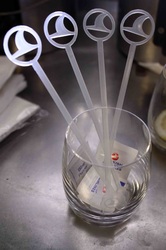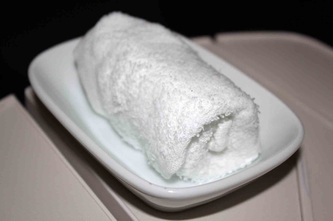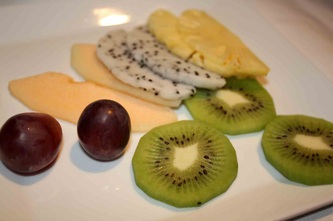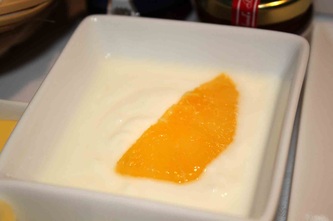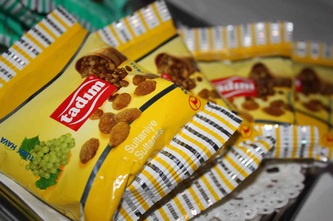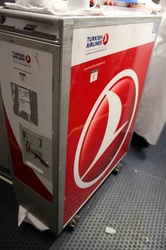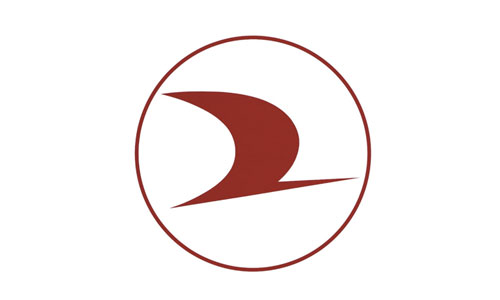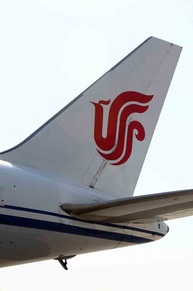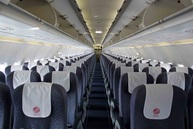|
Located around 32km outside of the city centre, Beijing Capital Airport may be considered to be a city within itself. Beijing Capital International Airport, at a floor area of 26,340,000 sq ft, is currently the second busiest airport in the world (as of 2011) in terms of passenger throughput behind Hartsfield-Jackson Atlanta International Airport. In fact even though Beijing Capital Airport has had a new terminal and a new runway (Terminal 3 was completed just before the Beijing Olympics), apparently the airport, with its huge size, is not large enough to accommodate the rising number of aircraft movements. Therefore, due to limited capacity at Beijing Capital International Airport, a new airport in Daxing is being planned with construction expected to begin in 2014 and be completed in 2018. The airport will have six runways for civil use and one for military use.
Most of the photos taken below are from Terminal 2. This terminal took over some of the airline movements from Terminal 1, and houses China Southern Airlines, China Eastern Airlines, Skyteam, Air Koryo, and other domestic and international flights. A gate capable of handling the A380 (gate 21) was also built at the terminal. From here China Southern Airlines operates A380 flights to/from Shanghai, Guangzhou and Hong Kong (at the time of writing). As I found out on one of my many visits to the airport, Terminal 2 can throw a few aviation gems here and there! DRAGONAIR (Hong Kong International to Guangzhou Baiyun Airport, AIRBUS A330-300, BUSINESS CLASS12/16/2012
Dragonair is an award-winning regional airline of Hong Kong, and is a proud wholly owned subsidiary of the Cathay Pacific Airways Group. Formed in May 1985, and having started services initially with just one Boeing 737-200 aircraft, Dragonair has in time become one of the world’s best regional airlines.
As a wholly owned subsidiary of Cathay Pacific Airways, the airline operates one of the youngest and most modern fleet with 36 aircraft on scheduled services to 41 destinations in Mainland China and elsewhere in Asia using three aircraft types: Airbus A330-330, Airbus A320-200, and the Airbus A321-200. The Airbus A330-300 aircraft come in three types of configuration: type 1 aircraft are designed to carry up to 284 passengers in three classes. They are used on the Beijing and Shanghai routes; type 2 aircraft are designed to carry up to 315 passengers in two classes. They are used on the Kaohsiung and Taipei routes; and type 3 aircraft are designed to carry up to 300 passengers in two classes. They are used on the Dhaka, Bengaluru (Bangalore), Taipei, Kaohsiung and Qingdao routes. Cathay Pacific is a founding member of the Oneworld alliance, with its subsidiary, Dragonair, as an affiliate member. In 2011, Dragonair was voted the ‘World’s Best Regional Airline’ by Skytrax for the second consecutive year. The airline is renowned as a China expert, serving 20 cities in mainland China. Though the Hong Kong to Guangzhou route is only 30 minutes (can sometimes take around an hour depending on the air traffic), this route provides many connecting flights from Hong Kong to around the world with Cathay Pacific Airways or Dragonair. Guangzhou is home to millions of wealthy overseas Chinese diasporas (i.e. Canadian-Chinese, British-Chinese, Australian-Chinese, American-Chinese etc.), and so the Dragonair flight between Hong Kong and Guangzhou provides excellent and smooth connections, without the hassle of these passengers having to take hours to travel by train or bus first (and saves the headache of crossing the Hong Kong - Shenzhen border). Usually when I have flown between London and Hong Kong, I have flown directly to Hong Kong (except one time in 2004 when I did take a connecting flight from Hong Kong to Guangzhou with China Southern Airlines on their old Boeing 757-200). I was flying from London Heathrow to Guangzhou with Cathay Pacific Airways, and so I decided to take advantage of this useful connecting flight from Hong Kong and Guangzhou. It turned out to be much better than I expected. If anyone is flying from London (or other destinations around the world with Dragonair or Cathay Pacific Airways) to Guangzhou then I would highly recommend this connection because the quality of comfort, service, and the professionalism of the staff is one of the best in the world. Check it out: Departure date and time of flight: November 2012, 08:00am Flight number: KA782 ATC Callsign: Dragon Flight duration: 35 minutes Class: BUSINESS CLASS Aircraft type: Airbus A330-342 (17 aircraft of this type in service- although only 5 of those aircraft have a configuration same as this aircraft.) Aircraft registration: B-HLB Aircraft Serial Number: 83 First flight: 9th February 1995 (nearly 18 years old!) Aircraft delivery date: 1st March 2011 (aircraft was previously with Cathay Pacific Airways since 1995) Aircraft engine types: 2 x Rolls Royce Trent 772-60 Frequent flyer programme: Marco Polo Club Seat configuration for this aircraft: 44 business class in a 2-2-2 configuration 267 economy class in a 2-4-2 configuration Punctuality of the flight/route taken: Departed on time, and landed on time as well. The short flight of around 73 miles provides a very non-scenic route from Hong Kong to Guangzhou because of the dusty and cloudy skies over Guangdong province. The flight leaves Hong Kong, and goes over Zhuhai, Dongguan, and then straight down towards Guangzhou approach (landing from either the city side, or the Baiyun mountainside). For this short flight, we climbed to 23,000 feet within 10 minutes, and then started the decent soon afterwards. Lounge experience at Hong Kong Airport: Cathay Pacific Airways, and Dragonair have 5 lounges at Hong Kong Chep Lap Kok Airport for their First and Business Class passengers. They are: The Wing The Pier The Cabin The Arrival G16 Lounge As I arrived at gate 16 from my London flight, the nearest lounge that I could refresh myself at was the G16 Lounge. Like all of the other lounges, the lounge is on the 2nd floor, well placed like a gallery from where you can get panoramic views across to the airfield, and the gates. The G16 lounge houses nice showers, comfy sofas, and delicious food all throughout the day and night. There is no harm tucking into one of the best-made Cumberland sausages and Heinz baked beans after a 12-hour flight. Cathay Pacific Airways and Dragonair have made their lounges very welcoming and comfortable, and they do feed you well (so therefore, there is no need to run to the nearest MacDonald’s after you land at Hong Kong!). G16 lounge is mostly catered towards passengers flying with Dragonair, and that’s one of the reasons why the furniture also comes in lovely shades of imperial red or creamy yellow leather. Any baggage issues: No issues. Comments on the check-in staff and any issues: I landed into Hong Kong from London Heathrow on Cathay Pacific Airways flight CX252 at around 6.45am. We docked at gate 16, and my onward connecting flight to Guangzhou was at 8am from gate 61 (which is around twenty minutes from gate 16- quite a walk!). There was no need to check-in, but all connecting passengers are smoothly ushered through a separate security channels. The Automated People Mover (APM) takes passengers between gates 20 and 40 quickly and smoothly. The whole journey from the G16 Lounge to gate 61 took around 15 minutes at the most. In-flight magazine: Silkroad (published by ACP Magazines Asia Limited) Comments regarding the pre-meal service: Business Class passengers were offered a choice of champagne, orange juice, tomato juice, and apple juice out of a hand tray service provided by the crew members. A choice of either sparkling or still mineral water is also offered. There is a 500mL bottle of Evian water behind each Business Class seat. The signature drink to try is the ‘Dragon Sunrise’- a refreshing fusion of gin with fresh guava, and fresh lemon juice. All Business Class passengers are handed out hot hand towels just prior to the meal service. The towels have a lemon scent. Comments regarding the first meal: For such a short flight, there is no formal meal service. It only takes around 10 minutes after take-off before the Captain announces that we are going to commence the decent into Guangzhou! Dragonair offer scrumptious onboard menu choices that are changed every two weeks. Business Class passengers are presented a box containing four types of assorted cold canapés and fresh fruit. On this flight, my box contained: · Smoked salmon and cream cheese · Pork pastrami tortilla wrap · Artichoke and brie · Fresh fruit (cute slices of strawberry, mango, watermelon, and melon) Though not required for such a short flight, food is usually served on stylish china tableware specially adapted from the Lifestyle collection of Wedgwood from the UK. To enjoy the food at its freshest, it’s best to consume it before landing. Comments regarding the drinks service: A second round of drinks was offered after the meal. This included 12 kinds of coffee and tea should be enough to make anyone spoilt for choice. Should any passenger want wine or champagne (even if it is the morning!), then these drinks are served in exclusively designed glassware. The champagne is provided by the award-winning Piper-Heidsieck Brut. The wine list for this flight included: White Wines: Macon Villages Blanc, Vaucher Pere & Fils, Burgundy 2010, France Wente Morning Fog Chardonnay, Livermore Valley & San Francisco, California 201, U.S.A. Red Wines: Cotes de Duras, Baron de Venzac 2012, France Luis Felipe Edwards, Family Selection, Gran Reserva, Shiraz 2012, Chile. Some of the specialties on Dragonair include: Fook Ming Tong Chinese tea, Fujian first class oolong tea, Hong Kong style milk tea, Fuding jasmine silver fur tea, and freshly brewed coffee. Comments on the in-flight system (if any): Each seat features a 10.4" personal video screen (same size in both Economy and Business Class cabins). Each flight has a choice of 10 PTV video channels and 16 audio channels from Dragon On Air in-flight entertainment programming. However, on such a short flight, there was hardly any need to watch any programs, except for the moving map which is also displayed on the huge screen at the front of the cabin. The playback music that welcomes passengers while on boarding and while disembarking the aircraft changes every month. For this particular flight we had ‘Dance on the Moon’ by Patrick Kelly (on boarding), and ‘Dream of the Pink Zebra’ by Suzanne Ciani; Young Russia Orchestra. It's a much better selection than what you get on the majority of the airlines in mainland China (which is usually having to listen to Kenny G's 'Going Home). Nothing against Kenny G, and nothing against his music, but do you really want to listen to just ONE tune every-time a plane lands and take-offs, and on every flight?! All aircraft have the Airbus KID 110V AC SkyPower in-seat power outlet for laptop computer and portable electronic devices in every seat. This requires no adapter cable. Dragonair was the first airline to offer this technology within the operational network for mainland China. Comments of professionalism of the cabin crew: The staff are very proud of their brand image and represented their airline at the highest level possible. When under a situation of high pressure, the staff seemed to act with professionalism and integrity. The cabin crew uniform design consists of a black blouse with thin red stripes, and a neck silk scarf in navy blue and red colours. Dragonair's current uniforms are designed by renowned Hong Kong designer, Eddie Lau. Comments on the interior of the aircraft (including seat comfort): For A330-300 on which I was flying, the Business Class cabin accommodates 44 passengers in a 2-2-2 seat design while Economy Class cabin caters for 267 passengers in a 2-4-2 setting. The seats in Economy Class on the Airbus A330-300 have a pitch of 32” recline, and are 17.5” wide. The seats in Business and Economy class are manufactured by various suppliers: BE aerospace, Zodiac France, Geven aircraft seating, Recaro Aircraft Seating, while those in first class are manufactured by Zodiac. Business Class seats on the Airbus A330-300 have a pitch of 63” recline (flatbed), and are 26.5” wide. The minimum in-flight sleeping angle is of 6.8° (when airborne). Each seat has an extendable leg rest, and a footrest, as well as a six-way adjustable headrest. The Business Class seat is ergonomically designed to be comfortable whether the passenger is working or relaxing. The Business Class cabin is upholstered in a refreshing and contemporary aqua blue; while the Economy Class is upholstered in shades of aqua blue, imperial red, and sky blue. Dragonair logo and brand livery Dragonair’s livery consists of having an all white fuselage, and underbelly. The tailfin consists of a imperial red dragon against a white background, and the same design is applied to the engines. At the front of the fuselage, just before the first cabin door, and below the cabin windows the words ‘DRAGONAIR’ are printed in English, in black ink and in capital letters; while the Chinese equivalent is printed in imperial red ink, and above the cabin windows (above the English words). The tips of the wings are coloured in imperial red ink. Below the tailfin, just in front of the back cabin door, is the flag of the Swire Group. The current Dragonair logo, modified from the previous version, was introduced in 1993 coinciding with the delivery of Dragonair's new fleet of Airbus A320s back then, with a new livery. The livery design gives a streamlined and contemporary look that reflects the dynamism and energy of the airline. Aircraft are given a pristine, overall white look, with the Dragonair name in clean black lettering. Red is used in the Chinese version of the name and in the dragon motif, in a strong and sophisticated shade. The cabin crew uniform design consists of a black blouse with thin red stripes, and a neck silk scarf in navy blue and red colours. While Dragonair has been a wholly owned by the Cathay Pacific Group since September 2006, the airline continues to operate as a separate airline under its own Air Operator’s Certificate. The Dragonair brand remains unchanged and the airline’s own 2,400 staff consisting of cockpit and cabin crew fly its own aircraft in the existing livery. In 2010, Dragonair celebrated its 25th anniversary, and to mark the auspicious occasion, an Airbus A330-300 was painted in a special livery with the red dragon painted across the whole fuselage against a backdrop of Hong Kong’s skyline in green. Just under the cockpit windows it writes ‘Hong Kong’ in capital letters, and there is a painting of the famous Hong Kong Star Ferry. Official SKYTRAX 5-star airline Cathay Pacific Airways is an international award-winning scheduled airline registered and based in Hong Kong, offering passenger and cargo services to 162 destinations in 42 countries and territories around the world. At the time of writing Cathay Pacific is one of only six global airlines that are ranked as a 5-star airline by SKYTRAX (the highest ranking for global airline quality).
The company was founded in Hong Kong in 1946 by two visionaries, Roy Farrell and Sydney de Kantzow, who both paid HK$1 apiece to register the airline. They named the airline, Cathay Pacific Airways. Cathay is the ancient name for China, while Pacific was named because far-sighted Farrell believed that one day the airline might fly across the Pacific Ocean. The airline initially started services with two US Army surplus Douglas DC-3 Dakota aircraft: Betsy and Niki. The former aircraft, Betsy, is suspended from the ceiling at the Hong Kong Science Museum, and is repainted in her original 1940s livery. Cathay Pacific Airways remains deeply committed to its home base, and has in recent years made substantial investments to develop Hong Kong as one of the world’s leading international aviation hubs. In addition to its fleet of 136 aircraft, (includes 26 cargo freight aircraft), these investments include catering and ground-handling companies and the corporate headquarters at Hong Kong International Airport. Cathay Pacific continues to invest heavily in its home city and has another 94 new aircraft due for delivery up to 2019 (including the 48 A350-XWB (Extra Wide Body)). The airline is also building its own cargo terminal in Hong Kong that will begin operations in early 2013. Cathay Pacific is also investing heavily in its freighter aircraft, with six Boeing 747-400ERFs, and 10 new generation Boeing 747-8Fs being scheduled for delivery by the beginning of 2013. Cathay Pacific owns 19.53% of Air China Limited, the national flag carrier and a leading provider of passenger, cargo and other airline-related services in Mainland China. Cathay Pacific is also the major shareholder in Air Hong Kong, an all-cargo carrier offering scheduled services in the Asian region. In November 2012, Cathay Pacific Airways was named Best Airline in the World and Best Airline First Class in the 2012 Business Traveller China Awards. The annual awards, now in their eighth year, reflect the highest praise bestowed by China’s frequent travellers on various service providers with connections to the Mainland. The awards were presented in Shanghai in November 2012 as Business Traveller China celebrated its 10th anniversary. The results of the 2012 awards were based on the magazine’s reader poll which ran from July to September this year. Commenting on the awards, Cathay Pacific Chief Executive John Slosar said: “It is a great honour for our airline to receive these two awards from Business Traveller China. As Hong Kong’s home carrier, we have worked hard to develop a world-class international network from our home city, offering passengers top-notch products and the best service in the air. We are deeply committed to developing Hong Kong as a premier aviation hub and gateway to Mainland China through building convenient connections for travellers.” Cathay Pacific and its subsidiaries employ some 29,000 people worldwide (more than 22,000 of them in Hong Kong). Cathay Pacific is listed on The Stock Exchange of Hong Kong Limited, as are its substantial shareholders Swire Pacific Limited and Air China. The airline is a proud founding member of the Oneworld alliance, with its subsidiary, Dragonair, is an affiliate member. The airline celebrated its 60th anniversary in 2006; and as of October 2009, its major shareholders are Swire Pacific and Air China. It is reciprocally one of the major shareholders of Air China. Cathay Pacific currently holds the title of the world's third largest airline, measured in terms of market capitalisation, according to the International Air Transport Association. Cathay Pacific Airways has four flights a day from London Heathrow Airport and Hong Kong (and four flights from Hong Kong and London Heathrow Airport), providing ample opportunities for business and leisure passengers to connect to flights throughout the Asia-Pacific, European, and Australasia regions at both ends. Being two major global economic hubs, both Hong Kong and London are key destinations for the large number of professional that are stationed at either destination. Cathay Pacific Airways introduced a new Premium Economy Class product on the 1st of April 2012. I decided to check out the airline’s relatively brand new Premium Economy Class seat from London Heathrow to Hong Kong on the Boeing 747-400 aircraft. Increasingly airline companies around the world are offering a Premium Economy Class product which is somewhere in between an Economy Class seat and a Business Class seat. This new Premium Economy Class will be progressively introduced on the airline’s Boeing 777-300ER, Boeing 747-400, selected Airbus A330-300 and Airbus A340-300 aircraft. Aircraft deployment varies and availability is subject to operational requirements. The Premium Economy Class cabin has initially been featured on some of the following selected flights to/from: Sydney, Australia (CX101/100) Toronto, Canada (CX826/825/828/829) Vancouver, Canada (CX888/889) New York City, United States (CX830/831/840/841/888/889) London, United Kingdom (CX252/255) More routes will eventually be added by the airline as the fleets are fitted with this new configuration. Route: LONDON HEATHROW (LHR) to HONG KONG (HKG) Departure date and time of flight: November 2012, 11:30 Flight number: CX252 (Cathay 252 heavy) ATC Callsign: Cathay Flight duration: 10 Hours 55 minutes Class: PREMIUM ECONOMY CLASS Aircraft type: BOEING 747-467 (17 aircraft in service, though currently only 4 aircraft fitted with the Premium Economy Class cabin) Aircraft registration: B-HUB Aircraft serial number: 25873 LN:937 Test Registration: N60665 Engines: 4 x RR RB211-524G/H-T Delivery Date: 9th October 1992 (as VR-HUB, and then B-HUB on 23rd October 1997*) *Before 1997, Hong Kong registered aircraft were labelled VR, and after 1997 all Hong Kong aircraft registrations complied with Chinese aircraft registrations, which start with B. So for example, VR-HUB became B-HUB after 1997 and so on. First flight: 10/09/1992 Frequent flyer programme: Marco Polo Club Seat configuration for this aircraft: First Class: 9 suites in a 1-1-1 configuration Business Class (upper deck): 22 seats in a 1-1 configuration Business Class (main deck): 24 seats in a 1-2-1 configuration, Premium Economy Class: 26 seats in a 2-4-2 configuration, Economy Class: 278 seats in a 3-4-3 configuration Punctuality of the flight/route taken: The flight departed around 30 minutes late because of the heavy traffic at Heathrow Airport, however because of the route we took we landed around 15 minutes early than expected at 6.45am local time in Hong Kong (there were no delays or hold-ups around Hong Kong control). Having push backed from our gate at Terminal 3, we made our way towards the holding point of runway 27R on the outer taxiway (meanwhile runway 27L was being used for landings). We had a few aircraft lined up ahead of us as it was a typical busy morning at Heathrow. These consisted of Thai Airways A340-600 going to BKK, Virgin A330 going to JFK, United B777 off to Newark, Air Canada 767 off to Toronto, Air India B777 off to Delhi, and an American B777 off to Chicago. Therefore, therefore we had a little wait at the holding point of the runway. When I was a kid I used to do aircraft spotting right across the fence at the threshold of runway 27R, so it was a nice feeling to be inside an aircraft and see the view from a different angle- it kind of puts things into perspective. After take-off we made a straight heading towards Daventry foxtrot at around 6,000 feet before heading towards Clacton control (around 25,000 feet), before making our way across to mainland Europe and Russia (went right over Minsk) onto the famed Trans-Siberian route. Entering China over the Kashgar region (coming in from Novosibirsk), then Urumqi, then Qinghai, and finally making a direct approach into Guangxi, Guangdong, and final decent into Hong Kong from over Macau. Landing was made on runway 25L at exactly 06:45am local time. We were welcomed with a wet and cold Hong Kong. Like any other major airline, Cathay Pacific does not keep its aircraft on the ground for long. B-HUB was being readied for the return flight to London Heathrow as CX257 in around 90 minutes time. This particular aircraft, a Boeing 747-400, has been flying in service with Cathay Pacific for over 20 years, and has probably another 5 or 6 years left before she is sold, or scrapped off. Any baggage issues: Premium Economy Class passengers are allowed to have a little bit more weight allowance than on Economy Class. Before boarding, passengers are provided with dedicated check-in counters and priority boarding at the gate. The amount of baggage allowance in Premium Economy Class is increased from 20kg to 25kg (weight system) or two pieces of baggage from 23 kg to 25kg each (piece system). Comments on the check-in staff and any issues: Cathay Pacific Airways use Terminal 3 at London Heathrow Airport. I checked-in about 2 hours prior to my flight. On the way to the check-in desks, I happened to bump into the Captain, and the Cabin Crew for the flight. The Captain briefly explained to me about the route that we were expecting to take today. The atmosphere was all positive and fired up for the flight. Everyone was in an upbeat mood. Taking a long haul flight is always an exciting time no matter how many times you have flown. Every pilot will tell you that no flight is ever the same, even if they fly the same route day in day out. The check-in staff were very professional and polite. There were no issues, and the whole process from check-in to the airline lounge took around 15 minutes. Lounge experience at London Heathrow Airport: The Cathay Pacific Airways lounge for First and Business Class passengers is located at area B after security at Terminal 3. The lounge is shared with Finnair. Oneworld Alliance members and Marco Polo Club members (silver, gold, and, diamond members only). The spacious lounge provides a space for relaxing before the flight in tranquil surroundings. Plenty of good and healthy buffet style food, along with various drinks was available. I made full use of the complimentary Wi-Fi to check my e-mails prior to leaving for China. On top of this there are plenty of international and local newspapers and magazines to while away your time with. Washroom and shower facilities are also tip top, with amenities provided by Murad (same as the in-flight amenities for Business and First Class passengers). In-flight Magazine: Discovery (published by ACP Magazines Asia Ltd) Comments regarding the pre-flight service: Passengers in Premium Economy Class are welcomed with a glass of champagne (Billecart-salmon Brut champagne), and a choice of either apple juice, orange juice or water. A hot towel is also provided to freshen your face, and those tired hands. A complimentary bottle of water is presented for the flight, as well as the in-flight amenity kit (this part is explained later in the article). Comments regarding the pre-meal service: Around about 35 minutes after departure, drinks were served from the trolley along with the helping of a packet of salted almonds (provided by Blue Diamond- Smokehouse company). I opted for another glass of fresh orange juice. During a long haul flight, it is good to water down as many non-alcoholic drinks as possible as to stop the effects of dehydration hitting you. There was also a complimentary bar service for Premium Economy Class passengers that included various alcoholic beverages, and soft drinks. Ground coffee, and decaffeinated coffee or tea (English earl grey, Ceylon, and Chinese green tea) were also available. On top of this, there were a selection of herbal teas including green tea with jasmine, peppermint, and camomile with honey. The wine list for Premium Economy Class passengers included: White Wines: Mosel Riesling Feinherb, 2011 (Germany) Obikwa Western Cape Sauvignon Blanc, 2011 (South Africa)- this wine was not available as for some reason they did not load it onto the aircraft. Red Wines: Dourthe Beau- Mayne Bordeaux, 2010 (French) Esprit De Serame Canernet Sauvignon, 2009 (French) Ample choice of whiskies (Chivas Regal 12 Year old, Johnnie Walker Gold Label), Cognac (Hine, ‘rare and delicate’ fine champagne), and various beers, aperitifs & cocktails, and liqueurs. Comments regarding the first meal: A larger meal table makes working and dining more of a pleasure, and a cocktail table provides more room during the meal service. Starters: Apple and celery salad A fusion of green apple cubes mixed with celery and some herbs (thyme I believe). The sweetness of the apples and the slight bland and crunchiness of the celery provided a lovely combination of flavours. Main Entrée:
I opted for the fish. This dish was not just good; it was out of this world. It came across as an international dish with a Chinese twist. The codfish was the international part (nice to have on a flight), while the rice and the vegetables that went with the fish was the Chinese twist (fish with rice as opposed to fish & chips….well, since when did you have chips being served at a pressurised altitude!). Another inspiration from the world-class chefs at Cathay Pacific City in Hong Kong. Dessert:
You can’t go wrong when you are presented with the finest ice-cream that mankind can make. Beechdean is made from fresh thick milk that derives from the healthiest cows around in this world. These cows ought to be very proud themselves that people eat ice-cream made from their milk high up in the air somewhere over exotic locations that only they can dream of flying themselves (that’s IF cows can have wings…unless they do end up as unfortunate cargo, alas maybe on Cathay Pacific Freighter services). The only thing is that cows, unlike humans, of course cannot speak except moo a bit here and there. Nevertheless, the ice-cream was top notch. Comments regarding the after meal drinks and in-flight snacks: Throughout the flight, Premium Economy Class passengers could help themselves to complimentary hot pot noodles, various drinks (alcoholic and non-alcoholic), and a selection of various sandwiches (cute & small sandwiches), crisps (walker’s), biscuits, fruit (apples), and chocolates (provided by Praline or Green & Black’s). Premium Economy Class passengers are pampered and looked after quite well during long haul flights! Comments regarding the second meal (breakfast): The second meal (breakfast) was served around two hours prior to landing at Hong Kong. Hot towels were handed out to each Premium Economy Class passengers prior to the meal service, and a selection of drinks service offered. Starters:
Main entrée
I opted for the English breakfast, which tasted much better than I had anticipated when I glanced upon it. If you look at the photo of the dish, it looks like a mashed curry with a sausage placed over it. Indeed, the ‘mashed curry’ is the creamed spinach along with that ridiculously delicious scrambled egg with the herb potato topping. Each spoonful was enough to want more, and make your mouth water. The breakfast meal was accompanied by tea, or coffee. Jam was provided by Wilkin & Sons, and the butter by Kerrymaid. Comments on the in-flight entertainment system: There is extra storage space for all those personal items you’d like to keep close at hand, and an environmentally friendly amenity kit comes with toothbrush and toothpaste, socks and an eye-shades – which is a perfect complement when it’s time to sleep. Huge headphones with noise cancellation technology were offered in the Premium Economy Class cabin. When it comes to entertainment, you’ll be spoilt for choice. For entertainment in Premium Economy Class, you can count on hundreds of selections on your StudioCX in-flight entertainment system. Plus, you can use the multi-port connector to stream audio and video from your personal devices to your new 10.6-inch widescreen Personal TV with a noise-cancelling headset to enhance your enjoyment. For Economy Class: Cathay Pacific's award-winning StudioCX entertainment system with Audio and Video on Demand looks especially good on the touch-screen monitor of the 9-inch Personal TV. Passengers can connect their iPod, iPhone or iPad* to stream their own music and movies to the screen. There’s a USB port to charge your mobile devices, and a 110V AC power supply for your laptop computer and other electronic devices. Connections enabling passengers to listen to, or watch on their individual screens, content on their personal iPods or USB devices are available on this aircraft (the Boeing 777-300ER). The music played upon boarding and upon dis-embarking the aircraft changes every month on Cathay Pacific flights. Some of the tunes played include ‘Prelude to Dawn’ by Howard Green, and ‘Feel’, by Robbie Williams. Comments of professionalism of the cabin crew: The cabin crew appear to have been trained very well, and seem to know how to handle all kinds of situations. The trainers must have had everything thrown at them, ranging from rowdy passengers to those having a nervous breakdown. These guys are amazing. They really do pamper you. To the outsider it may seem that being cabin crew is an easy job, however in fact it’s a very challenging job, and there is more to the job then just handing out the meals. With many months of hard work and training under their belt, cabin crew members are chosen very carefully by the airline. Interestingly on our flight we had a passenger who was very worried and got scared mid-flight. The cabin crew did a fantastic job in calming the situation down. Like they say in the corporate world, you may have the best brand in the world, but that brand is worth nothing if it not for the people that make great things happen for that brand. Cathay Pacific Airways stand by their words, and truly give a 5-star service. If you are a frustrated passenger (for whatever reason), then let me reassure you that the cabin crew are always trying to go through great trouble to make your flight as comfortable as possible. I am saying this from personal experience. As a frustrated passenger (we have all been in that situation at some point or another in our lives), it can be easy for some of us to lose their cool when things are not going as we expect them to be. It’s because of the professionalism and integrity of the cabin crew that the airline is classed as a truly 5-star airline that endeavors to provide a truly 5-star service to its customers. Cathay Pacific's current uniforms are designed by renowned Hong Kong designer, Eddie Lau. Ladies wear a red skirt with a white blouse that has the ‘brushwing’ logo in gold and red colours. The ladies also have a bright red blouse jacket which they can wear- matching with the red skirt. The gentlemen wear black starched trousers with a white shirt. Along with that the men wear a red tie with black stripes (junior cabin crew), or a gold tie with black stripes (senior cabin crew). On this fight, the majority of the crew (including all the pilots) were London based, and were British. The same applies for flights that originate from Canada, USA, and Australia where locally based staff are recruited by the airline to give that personal touch when it comes to customer service. I would like to give full thanks to the senior cabin crew in charge of the economy and premier economy class cabins. I could not imagine handling the situation with the sheer calmness, and composure with she managed to deal with on this particular flight. It goes without saying that not everyone can do this highly charged and pressurised job. The senior purser, and her fellow crew, deserve a huge golden medal. I am not saying this because I want to impress anyone, but I am writing this because this is the truth, and as a witness to a particular situation on this flight (which I am not going to mention in public). Comments on the interior of the aircraft (including seat comfort): When I entered the new Premium Economy Class cabin, it smelt the same as the interior of a brand new car out of the factory. The Premium Economy Class experience features a quieter, more spacious cabin than the traditional Economy Class with between 26 and 34 seats per aircraft (26 seats on the Boeing 747-400). The seat pitch is 38 inches – six inches more than Economy Class – and the seat itself is wider (19.8”) and has a bigger recline (8”). Passengers in Premium Economy Class receive an environmentally friendly amenity kit with dental kit, socks, eye-shades, and earplugs for use during their journey. The amenity kit bag itself is a little creation that contains some beautiful art work designed by home-grown Hong Kong brand G.O.D. (Goods of Desire). The seat itself looks and feels like the old style Business Class seats that one would have experienced in the 1980s and 1990s. I found the experience to be much more comfortable than business class. Each Premium Economy Class seat comes with a soft pillow stuffed with dove feathers, and a nice cosy blanket. There is plenty of space to place your shoes too. The Premium Economy Class seat is meant to be somewhere in between an Economy Class seat and a Business Class seat. As more and more global airline companies are transiting to a flat-bed style Business Class seat, so there is a growing demand for seats that are reasonably priced and offer a comfortable experience where you can stretch your legs yet there is no need to pay thousands of pounds for the experience. Some airlines in the process are also eliminating their First Class cabins altogether. By end of this year, Cathay Pacific will have 48 aircraft installed with the new product comprised of 23 Boeing 777-300ERs, 17 A330-300s and eight Boeing 747-400s. By the end of 2013, 87 aircraft in the airline’s long-haul fleet will feature Premium Economy Class. The good news for those collecting air miles is that Asia Miles accrual for premium economy class will be at 110%. I found the journey to be very comfortable, and did not experience the back pain and aching muscles that you normally get after flying long haul in Economy Class. Cathay Pacific Airways logo and livery: Back in the 1980s and early 1990s, Cathay Pacific Airways used to support a green and white striped livery. This old livery was replaced with the current "brushwing" livery In 1994 the airline announced that it would establish its new corporate identity, with a 23 million Hong Kong dollar (RM 7.3 million) program to update its image. - Cathay Pacific relaunched its corporate image in the early 1990s. Cathay Pacific commented that after building a reputation over 50 years for technical excellence and high-quality service, Cathay Pacific had no intention of changing its core values. Therefore, the new corporate identity was merely intended to communicate these values more effectively to all current and future customers. Cathay Pacific worked with Landor Associates, the world’s largest corporate identity management firm, to help create the new identity. The brushwing livery expresses the carrier’s unique character as an Asian with an international outlook. The sophistication of the logo conveys Cathay Pacific’s technical expertise and uncompromising attention to safety and reliability. The brushwing also embodies a sense of energetic flight, and being a “handmade” symbol it acknowledges the company's devotion to high standards of caring, personal service. For more information check out www.cathaypacific.com/mypremiumeconomy This website contains a wealth of content based on personal travel experiences of different types of travellers, from those flying on a business trip to those flying for leisure, which may be good references to those who haven’t tried this new cabin before. THY Turkish Airlines is the award-winning national flag carrier of Turkey. Since being formed on 20th May 1933 with a fleet of 5 aircraft, Turkish Airlines has become a leading global airline company in its 80 years of distinguished service. Turkish Airlines is a proud member of Star Alliance, and operates from its global hub at Istanbul International Airport to 260 cities in 90 countries using 200 state-of-the-art aircraft. Turkish Airlines, which is a fully scheduled airline, carried 29.1 million passengers in 2010. It employs more than 14,000 people worldwide. In 2010, Turkish Airlines celebrated its 75th anniversary with a special ‘75’ logo painted on its aircraft and painted some its A320 aircraft in the old original 1970s airline livery. The initials 'THY' stand for Türk Hava Yollari (meaning Turkish Airlines).
In December 2012, Turkish Airlines finalized an order for 15 Boeing airplanes that will help it fly to more destinations globally. The order was valued at $4.7 billion at list prices although customers buying multiple planes often get a discount. Turkish Airlines currently has 12 777-300ERs and nearly 100 Boeing airplanes. The 777-300ERs seat up to 386 passengers in each individual aircraft. The Istanbul (IST) to London Gatwick (LGW) route is hugely popular with 14 flights a week between the two cities. Another strong connection between Turkish Airlines and the United Kingdom is that Turkish Airlines is the main sponsor of the Manchester United Football Club. The three and a half year ‘multi-million’ pound deal was signed in 2010. The airline has invested a lot of money in working with big brands and prompting its own brand globally. In contrast to other European flag carriers in the 21st century, Turkish Airlines is proud to be the fastest growing airline in Europe and has been consistently been voted the best airline in Europe by its passengers and officially by SKYTRAX. Recent announcements in 2012 solidified Europe’s Best Airline’s Partnership with global sports figures. For example, International soccer superstar Leo Messi was named Global Brand Ambassador for Turkish Airlines at a ceremony in September 2012 at the Camp Nou Stadium in Barcelona, Spain, after signing the agreement. The FC Barcelona forward joins the ranks of Los Angeles Lakers star Kobe Bryant and professional tennis player Caroline Wozniacki who have been brand ambassadors since 2011 and 2010 respectively. Turkish Airlines now officially flies to more destinations globally than any other airline. In the United Kingdom, apart from London Gatwick, Turkish Airlines also flies regular scheduled flights to London Heathrow, Birmingham, Manchester, and Edinburgh (THY used to fly to schedule flights to Stansted, now it is just for charter flights). In total Turkish Airlines operates 65 flights a week between Istanbul and the United Kingdom, including 44 flights a week between London and Istanbul (Heathrow and Gatwick combined). Another strong indicator of this is that because Turkish Airlines is a proud member of Star Alliance, whose members also include Lufthansa, United Airlines, and BMI. So therefore, because of this link with Star Alliance, this flight was in code share with Lufthansa and BMI. Turkish Airlines usually operate the Istanbul to London Gatwick route using the Boeing 737-800. However on this occasion the Airbus A321-231 was deployed, and it was a pleasure to fly this beautiful aircraft. I decided to check out their Business Class on this relatively short haul daytime flight. Route: ISTANBUL (IST) to LONDON GATWICK (LGW) Departure date and time of flight: December 2012, 12:25pm local time (Istanbul) Flight number: TK1997 IACO Callsign: Turkish Flight duration: 3 Hours 50 minutes Class: BUSINESS CLASS Aircraft type: AIRBUS A321-231 (32 aircraft in service) Aircraft registration: TC-JRS (Delivered on 29th June 2011) First flight: 21st June 2011 Aircraft’s name: Datça Test registration: D-AVZJ Aircraft serial number: 4761 Aircraft Engines: 2 x IAE V2533-A5 Frequent flyer programme: miles & smiles In-flight magazine: SkyLife Magazine Seat configuration for this aircraft: Business Class: 28 seats in a 2-2 configuration, Economy Class: 152 seats in a 3-3 configuration Comments on the check-in staff and any issues: No issues. The security at Istanbul Airport is very tight. Passengers and their baggage are checked for security BEFORE they enter the airport building. At the check-in area, the security staff ask even more testing questions to make sure that you are the passenger. If they are suspicious then they will also ask you for another source of identification except your passport. On my flight to London, the security asked me if I had another source of identification to prove that I was British (because apparently so many illegal people enter the UK through Istanbul). I showed the security staff my British driving license. The check-in and security procedure was very smooth, and took around about 15 minutes. My gate for departure was 209, and I had around about an hour before boarding time. I decided to check out the beautiful Lounge for Business and First Class passengers for THY Turkish Airport. Any baggage issues: No issues regarding the baggage. With Turkish Airlines, passengers travelling on Business Class can carry 2-luggage bags upto 32 KG in total, with 2 hand bags of 8 KG each. Lounge experience at Istanbul The facilities at Istanbul airport have improved vastly since I was here last in early 2011. There is a beautiful lounge that is available for Business Class travelers, Miles&Smiles Elite card members with one guest, Miles&Smiles Elite Plus members with their family and Star Alliance Gold card members. It really is a lovely masterpiece of architecture that blends in well with a lovely ambiance. The only glitch I could see was that because of the audible open design of the roof, it was very easy to hear someone talking on the phone, even if they were sitting on the other side of the Lounge! I had no intention to but I could easily hear someone cursing and shouting on their phone, and then I looked around and thought where is that noise coming from? Only when I looked into the distance on the other side of the Lounge I realised that the person whose voice I could clearly hear was actually sitting at least 100 meters away from me! Of course, he would not have realised unless someone had told him- and for the fear of being shouted at, I never did tell the poor chap. Overall the Lounge is really amazing. You can do anything you want. Surf the internet; eat delicious Western, Chinese, Indian, and Turkish hot and cold meals. Plenty of fresh fruit juices to drink and plenty of spirits and wines too. Oh, there is even a pool table, and a well stocked library, and not to forget the complimentary Wi-Fi. It’s such a lovely place that you have to be careful not to leave it too close to your boarding time because if your gate is something like 209 (like mine was), then it’s around a 15-20 minute walk (maybe longer if you have children and family with you). If you wish, you may leave your boarding card with the CIP Lounge hostess who will inform you of the departure of your flight (in case you get lost in the comforts of the lounge as mentioned before). If you need to freshen up there are also shower facilities, so don’t forget to ask for your personal bath kit and towel at reception. For parents, a diaper changing trolley is also available. Toilets for both men and women are available and fully accessible by those with disabilities. For those wishing a meditation moment, the lounge also houses a Muslim prayer room. Punctuality of the flight and route taken: The flight departed on time, and landed a few minutes earlier than scheduled. The flight started initially with a straight climb out of runway 35L towards Eastern Europe- passing over Bulgaria, Bratislava and then entering German airspace. Through the flight the view was blocked by heavy cloud over mainland Europe until we got into Dutch airspace. We commenced our decent over Dutch airspace, which provided some fabulous views across to Rotterdam, Eindhoven, The Hague, and the English Channel. The City of London could easily be seen in the haze from somewhere over Southend-On-Sea. From the Dutch coast to the touchdown point only took around 20 minutes. Comments regarding the pre-flight service: Passengers in Business Class were offered welcome drinks consisting of fresh orange juice, fresh lemon juice, strawberry soda, and champagne. Usually what you find is that most ‘fresh orange juice’ drinks that form part of airline meals are heavily concentrated and taste like water with a splash of orange squash (or something similar), however it must be said that the orange juice on Turkish Airlines is authentically fresh orange juice (with the orange bits in as well). Perfect quality and it tastes extremely good. Highly recommended that you drink it without the ice, as it tastes even better (otherwise the ice will dilute the rich authentic taste). Comments regarding the pre-meal service: On Turkish Airlines, passengers in Business Class are offered a selection of drinks including fresh orange juice, fresh lemon juice, mineral water, and champagne. On this flight there were also a selection of international and Turkish wines and beers. White Turkish wine: 2008 Kavaklidere Narince (Anatolia) Red Turkish wine: 2007 Doluca Karma Turkish beer: Efes Pilsen Turkish liqueur: Tekel Ozel Uretim (sour cherry) On this flight, the welcome drinks were accompanied with a packet of Turkish hazelnuts and a selection of canapés. Turkish Airlines offers the hazelnut because it originates from Turkey, and forms part of Turkish cuisine. Comments regarding the main meal: Turkish Do&Co, the gourmet entertainment company, provides in-flight catering at Turkish Airlines with their colourful and inspiring menus containing equally sensational dishes. All the menus come written in both English and Turkish. A la carte menus are provided in business class while set meals are provided in the Economy Class. A round of fresh fruit juices and other drinks were offered to wake up the senses (just cannot stress how good it feels to drink that fresh orange juice!). The meal tray consisted of a load of seriously good food. First up was a tray containing freshly cut cheese slices, feta, and a thick cream, which went fine with fresh green and black olives. The following three were the options available for the main lunch dish: · Grilled swordfish with eggplant stuffed with red pepper and potato puree. · Fillet mignon and chicken medallion with mustard and curry sauce, sautéed vegetables and buttered rice · Cheese ravioli with parmesan sauce, sautéed musrooms and marinated red peppers I opted for the seafood option. The generous helping of the swordfish goes well with the incredibly delicious stuffed peppers and the potato puree. Turkish Airlines in flights have certainly improved a lot since the last time I was onboard in 2011, and they keep improving all the time. This food was too good. The red peppers are of an unbelievably first-class taste. Accompanying the main dish was a bowl of stuffed zucchini in olive oil (close enough to mum’s cooking!), a small bowl of assorted cheese, and a plate full of scrumptious prawn salad. The cabin crew offered a generous helping of a selection of warm ‘oven fresh bread’ from the basket that included freshly made croissants and Danish pastries. Passengers were again treated to a selection of freshly brewed coffee, which included both western coffee and Turkish coffee. Stainless steel cutlery in the business class cabin is provided by ‘Isik’, and proudly displays the engraved symbols ‘THY’ followed by the Turkish Airlines logo. All other cutlery in the business class cabin is provided in fine bone china, again with the Turkish Airlines logo and black ‘THY’ symbol engraved at the bottom of each piece. Comments regarding the after meal drinks and in-flight snacks: Passengers were treated to a selection of freshly brewed coffee, which included both Western coffee and Turkish coffee. Turkish coffee has a slightly stronger flavour and is normally taken without milk. A lovely cube of Turkish Delight is accompanied with the Turkish coffee. There was also a variety of digestives available including Baileys, Cointreau and Frapin VSOP Cognac. Good food like this should never be wasted. Throughout the flight, passengers were able to enjoy a variety of snacks including free flowing drinks (alcoholic and non-alcoholic) from the galley. Comments on the in-flight entertainment system: Huge headphones with noise cancellation technology were offered in the Business Class cabin. The 10.6-inch PTV screen, which is in place in the arm rest of every seat, can be used to watch movies, choose any kinds of music to play, watch how your flight is progressing, catch up on current affairs, or play computer games with. The digital AVOD (Audio Video on Demand) in-cabin entertainment system is in use on this route. Passengers can select their program either from the panel in the arm of the seat or simply by touching the screen. Programs the AVOD system fall into three categories: 'Information', 'Entertainment’, and 'Communications'. Altogether, there are over 120 channels and levels of entertainment to absorb during your flight. Then there is always the five-star quality in-flight magazine of Turkish Airlines, SkyLife, to keep you mesmerized with many stories and useful information. Connections enabling passengers to listen to, or watch on their individual screens, content on their personal iPods or USB devices are available on this aircraft (the Airbus A321-200). Comments of professionalism of the cabin crew: The hospitality on Turkish Airlines is just top notch. The staff are highly trained and provide a truly five-star service comparable to the likes of a top quality five-star hotel. Even in the most highly pressurised of situations, the cabin crew have a smile on their faces, and this is key difference that makes Turkish Airlines stand out from the rest. A quality that separates a good airline from a very good airline is one where the cabin crew at the very good airline will greet the passenger before the passenger greets the cabin crew. It has to be said that this mark of high quality stands out clear for the staff of Turkish Airlines on this flight. Comments on the interior of the aircraft (including seat comfort): The Business Class cabin of the Airbus A321-200 on Turkish Airlines has a 2-2 seat configuration. Because this was a medium haul flight (less than 5 hours), during the day and within the European region so therefore there was no amenity kit provided. There are 28-Business Class seats on the Airbus A321-200 each with 159 degrees recline providing a very spacious legroom. The Business Class seat has a 34.0” pitch and is 20.0” width. It reclines back enough for you to have a very comfortable rest for the flight. Lovely suede leather and cotton material that is pleasing for the eye. Each seat in Business Class has electronic buttons on the bottom left hand corner that control the seats movements. Economy Class seats have a configuration of 3-3 and have a 30.0-32.0” pitch and a 17.5” width. Each seat in Business Class comes with its own personal night light that is easy to control, as well as a built-in back massage system. If you need a back massage then all you need to do is press the button. The food tray is neatly placed inside the left hand armrest, while the Personal TV (PTV) screen is neatly placed in the side arm rests. There is also AC power and power available for your laptop built in every seat. This is a very convenient feature. In a nutshell, if you are a seriously minded business frequent flyer, have a hectic and busy business lifestyle where you are constantly moving around and need the essentials of business life at the touch of a button (even in the sky) then Business Class on Turkish Airlines is for YOU. Turkish Airlines logo and livery: The airline's striking logo consists of a crane flying inside a white circle symbolizing the common migration of the birds in Turkey. The logo is a crane bird with wings above the body. The simple yet powerful design of the wings also refers to the crescent in the Turkish flag. The "Eurowhite" livery consists of a snow white coloured fuselage with large navy blue ‘TURKISH AIRLINES’ lettering across the starboard and port side in capitals. On some smaller aircraft, such as the Airbus A330 and the Boeing 737-800, the word ‘TURKISH’ is written in capital navy blue letters, while ‘AIRLINES’ is displayed right underneath in light grey colours. The national flag of Turkey is displayed about one foot to the right hand side of the blue lettering. A huge silver coloured tulip is painted on the fuselage, running from the rear of the wing to the tail. The belly of the fuselage is painted in light grey. Every plane is named after a city or town in Turkey, or any of the seas and lakes scattered around the Turkey’s coastal waters. The tailfin of the aircraft is painted in a bright red colour with the company logo wrapped in a white circle. Recently a new logo was unveiled where the main change on the fin has been that the emblem is now white and on a red background, while it was formerly red and on a white background. The inscription "Turkish" has been replaced with "Turkish Airlines" on the front-left and front-right sides of the fuselage. The "Eurowhite" livery (a white fuselage with blue lettering) and a grey tulip figure on the fuselage (running from the rear of the wing to the tail) have remained the same. Priestmangoode is the company responsible behind the re-branding of Turkish Airlines as a key part of the airline’s strategy to position itself as a major European carrier. Priestmangoode delivered a complete re-design, starting with new interiors across the entire Turkish fleet. Overall rating 1-10 (worst-best): 10 THY Turkish Airlines is the award-winning national flag carrier of Turkey. Since being formed on 20th May 1933 with a fleet of 5 aircraft, Turkish Airlines has become a leading global airline company in its 80 years of distinguished service. Turkish Airlines is a proud member of Star Alliance, and operates from its global hub at Istanbul International Airport to 260 cities in 90 countries using 200 state-of-the-art aircraft. Turkish Airlines, which is a fully scheduled airline, carried 29.1 million passengers in 2010. It employs more than 14,000 people worldwide. In 2010, Turkish Airlines celebrated its 75th anniversary with a special ‘75’ logo painted on its aircraft and painted some its A320 aircraft in the old original 1970s airline livery. The initials 'THY' stand for Türk Hava Yollari (meaning Turkish Airlines). Turkish Airlines now officially flies to more destinations globally than any other airline. In December 2012, Turkish Airlines finalized an order for 15 Boeing airplanes that will help it fly to more destinations globally. The order was valued at $4.7 billion at list prices although customers buying multiple planes often get a discount. Turkish Airlines currently has 12 777-300ERs and nearly 100 Boeing airplanes. The 777-300ERs seat up to 386 passengers in each individual aircraft. The airline invest a lot of money in working with big brands and prompting its own brand too. Recent announcements in 2012 solidified Europe’s Best Airline’s Partnership with global sports figures. For example, International soccer superstar Leo Messi was named Global Brand Ambassador for Turkish Airlines at a ceremony in September 2012 at the Camp Nou Stadium in Barcelona, Spain, after signing the agreement. The FC Barcelona forward joins the ranks of Los Angeles Lakers star Kobe Bryant and professional tennis player Caroline Wozniacki who have been brand ambassadors since 2011 and 2010 respectively. In contrast to other European flag carriers in the 21st century, Turkish Airlines is proud to be the fastest growing airline in Europe and has been consistently been voted the best airline in Europe by its passengers and officially by SKYTRAX. The Guangzhou (CAN) to Istanbul (IST) route is a successful route, having started in February 2011. For this route, Turkish Airlines used to fly the brand new Boeing 777-300ER aircraft, however for the moment the airline uses the Airbus A340-300 aircraft. With the world’s major airlines focusing on cost cutting, it is no wonder that we are seeing a demise of the First Class cabin. So likewise, Turkish Airlines also has Business, Comfort Class (Premium Economy cClass- not on this aircraft), and Economy Class. Many major flag-carriers around the world are replacing their First Class cabins with Business Class (Virgin Atlantic, Air China, Continental Airlines are prime examples), and intact replacing their Business Class with Premium Economy Class cabins. Which does make sense because there is hardly much difference between First and Business Class, especially when most Business Class seats transform into flatbeds anyways. The Guangzhou to Istanbul route has become exceedingly popular with both Turkish and Chinese people because of the warm economic, political and tourist relations between Turkey and China. Presently there are four flights a week from Guangzhou to Istanbul and vice-versa (the last time I did a review for the CAN-IST route, it was only 3 flights a week). The flight from Guangzhou leaves at 23:10pm and arrives the following day at Istanbul at 5:25am, while the return flight leaves Istanbul at 23:50pm, arriving into Guangzhou the following day at 14:30pm. Most of the flights, including the one I took here (TK73) are full payload and full cargo as well. This gives the reader a strong indication of the strong partnership between Turkey and China, and the way the future of the aviation industry is going for these two countries. Both Turkey and China have ambitions plans in the pipeline to grow their aircraft fleets and airline routes for the commercial aviation sector between these two countries. In China, apart from Guangzhou, Turkish Airlines also flies to Shanghai, Beijing, and Hong Kong providing 25 flights a week to the region. Another strong indicator of this is that because Turkish Airlines is a proud member of Star Alliance, whose members also include Lufthansa, United Airlines, Shenzhen Airlines, Singapore Airlines, and Air China. So therefore, because of this link with Star Alliance, this flight was in code share with ‘Air China’. Focusing on Turkish Airline’s Business Class, incidentally – isn't difficult, however, especially once you’re on board. The cabins and service are top-notch, and you’ll definitely travel in sheer comfort. Enjoy the flight experience! Route: GUANGZHOU (CAN) to ISTANBUL (IST) Departure date and time of flight: December 2012, 23:10pm local time (Guangzhou) Flight number: TK73 IACO Callsign: Turkish Flight duration: 12 Hours 5 minutes Class: BUSINESS CLASS Aircraft type: AIRBUS A340-313X (7 aircraft in service) Aircraft registration: TC-JDN Aircraft’s name: ADANA Aircraft Engines: 4 x CFMI CFM56-5C4 Aircraft Test Registration: F-WWJU First flight: 1st August 1997 Delivery Date: 19th August 1997 Aircraft manufacturing serial number: 80 Frequent flyer programme: miles & smiles Seat configuration for this aircraft: Business class: 34 seats in a 2-2-2 configuration, Economy class: 236 seats in a 2-4-2 configuration Comments on the check-in staff and any issues: Guangzhou airport can get very busy and confusing in the evenings. The check-in desks at Guangzhou are much better managed now than they were a few years ago when international airlines were rare at Guangzhou. Even though this flight was full, there was no rush, and no hustle & bustle from the passengers or the check-in staff. The best part of it was that the check-in staff can speak very good English, a skill that was rare to find a few years ago in South China among any local staff. Things have certainly improved, not just for THY Turkish Airlines but for other airlines at Guangzhou as well. The check-in procedure did not take a long time either with only around a short 5-10 minutes wait in the queue. I was escorted by the airline station manager from the check-in desk to the gate. He allowed me to wander around the lounge (which is shared with China Southern Airlines), and then I met him again at gate A103. The check-in staff at the Turkish Airlines counters at Guangzhou Baiyun airport were very professional and helpful. I was surprised to see that Guangzhou Airport were using the peak hours to train their newly graduated security staff at the customs! There must have been thousands of passengers waiting to go through security, and board for the high number of flights that were departing that evening. While the security and customs queues were long, and equally managed properly, I do think that they could easily have been handled quicker (or perhaps they could have had the trainee staff stationed at a less busy time). All in all it took me around 15 minutes to wait and go through the security and customs (at Guangzhou Airport, security comes first, and then customs) Any baggage issues: No issues regarding the baggage. With Turkish Airlines, passengers travelling on Business Class can carry 2-luggage bags up to 30 KG in total, with two hand bags of 8 KG each. In Economy Class passengers can carry two luggage bags weighing 23 KG in total. At the time of writing free baggage allowance is 30 kg for Economy Class and 50 kg for Business Class from Odessa to Italy, Spain, Germany, Greece and Portugal. Punctuality of the flight, and route taken: The plane, an Airbus A340-300, was parked at gate A103, surrounded by other international airlines (Ethiopian B777, Emirates B777, Thai Airways A330, Cebu Pacific A320, ANA B767, Qatar Airways B777, and Egyptair B777). Evenings are indeed busy at Guangzhou as the vast majority of the flights go to North Africa, and the Middle East. We pushed back on time at around 23:20pm, and faced towards the north with a short taxi to runway 02R. Normally from Guangzhou to Istanbul, it should take around between 9 and 10 hours non-stop. However, this flight took 12 hours non-stop. Why? The Captain was kind enough to explain to me that there were two reasons for this. 1. If we took the direct route, then we would experience heavy turbulence over the high terrain Sichuan and Yunnan provinces that particular evening, and 2. Due to heavy traffic in the area, and around the Central European air space, ATC (Air Traffic Control), had scheduled our flight to head back towards Macau and Zhuhai after departure, and then head back over Hainan Island, Vietnam, North Thailand, Burma, India, Pakistan and then eventually re-joining the main flight path that leads to Istanbul. The plane entered Turkish airspace at around 2 hours prior to landing (when breakfast was served!), and then made over the Black Sea and then finally turning over the waters of Marmara Sea to make a straight approach into Istanbul’s runway 05 right on time as scheduled. In-flight magazine: SkyLife Magazine Comments regarding the pre-flight service: Upon embarking the aircraft, passengers in business class were offered welcome drinks consisting of fresh orange juice, strawberry drink, fresh lemon juice, Turkish mineral water, and champagne. Usually what you find is that most ‘fresh orange juice’ drinks that form part of airline meals are heavily concentrated and taste like water with a splash of orange squash (or something similar), however it must be said that the orange juice on Turkish airlines is authentically fresh orange juice (with the orange bits in as well). Perfect quality and it tastes exceedingly good. Highly recommended that you drink it without the ice, as it tastes even better. Comments regarding the pre-meal service: Passengers in Business Class were offered a selection of drinks including fresh orange juice, fresh apple juice, mineral water and champagne. There was also a selection of international and Turkish wines and beers. On the wine list menu one could see five options for red wine, 2 options for white wine, rose wine, champagne and various aperitifs: White wine options were: Prestige Narince 2011 – Turkish Chablis Premier Cru Les Beauroys 2008 – France Red wine options were: Doluca Karma Cabarnet Sauvignon Okuzgozu, 2010 – Turkey Chateau Lamothe Pontac Medoc, 20009- France Bodegas Beronia Crianza, 2008 – Spain Bodega Norton Privada, 2009 – Argentina Graham’s Late Bottled Vintage, 2007 – Portugal Rose wine: Kavaklidere Egeo, 2011 – Turkey Champagne: Gosset Brut Grande Reserve Turkish beer: Efes Pilsen Turkish liqueur: Tekel Ozel Uretim Turkish Raki: Efe yaş üzüm rakısı (fresh grape Raki) It would be a complete waste of a flight if you don’t try the Turkish liqueur, or the Turkish rose wine (unless, of course, if you don’t drink alcohol). So, what does it taste like? A little bit strong with a hint of sweetness and spicy flavour to it. You can almost feel the sour cherry touching the top of your tongue. It’s best if you take the Turkish liqueur with plenty of hazelnuts. Indeed, the drinks were accompanied with a bowl of Turkish hazelnuts and a selection of canapés. Even Economy Class passengers get the hazelnut. Turkish Airlines offers the hazelnut because it originates from Turkey, and forms part of Turkish cuisine. Comments regarding the first meal (dinner): Dinner was served around an hour after departure from Guangzhou- we must have been somewhere over the Hainan Island and making our way towards South-East Asia. Flying can be exciting yet also boring- depending whichever way you look at it. However, the fun and exciting part always comes when you are presented with the in-flight meal because at least you have something to do and keep yourself busy. Turkish Airlines has stylish menus, which they hand out to all the passengers in all the cabins prior to the meal service. Turkish Do&Co, the gourmet entertainment company, provides in-flight catering at Turkish Airlines with their colourful and inspiring menus containing equally sensational dishes. All the menus come written in both English and Turkish. A la carte menus were provided in Business Class while set meals were provided in the Economy Class. For starters, the following options were provided in Business Class: · Roast beef with balsamic sauce, avocados, tomatoes and black olives · Marinated prawns with mustard dressing, grilled asparagus, sun-dried tomatoes, with parmesan Talking of asparagus, Business Class passengers had the option of tucking into the traditional Turkish asparagus soup decorated with asparagus tips. Now, that is just sheer luxury food that no one should take for granted- not even when you are cruising. For the main course, there were three options available in Business Class: · Grilled salmon with herbed butter, sautéed asparagus, roasted tomato, saffron risotto · Ricotta ravioli with alfredo sauce, sautéed mushrooms, cherry tomatoes, parmesan · Fillet of lamb with rosemary sauce, pan-fried vegetables polenta Despite both the salmon and the ravioli having equally top quality taste I went for the grilled salmon. Having grilled salmon as part of a five-star in-flight meal is a luxury, though perhaps it’s not the real experience as one would have if they were eating in a restaurant at ground level. Accompanying the main dish were the following side dishes: · Spicy lentil salad · Leeks in olive oil · Small portion of chopped up tomatoes and cucumbers The cabin crew twice offered a generous helping of a selection of warm oven fresh bread from the basket- once before the main course and then again during the main course. The dessert tray contained the following: · Selection of cheese · Selection of fresh seasonal fruit · Green tea ice-cream · Various petit desserts including Turkish baklava and Turkish Delight (can’t be Turkish if you don’t have ‘Turkish Delight’, right?). · Baked apples with mascarpone cream Stainless steel cutlery in the Business Class cabins is provided by ‘Isik’, and proudly displays the engraved symbols ‘THY’ followed by the Turkish Airlines logo. All other cutlery in business and business class cabins is provided in fine bone china, again with the Turkish Airlines logo and black ‘THY’ symbol engraved at the bottom of each piece. Comments regarding the after meal drinks and in-flight snacks: Passengers were treated to a selection of freshly brewed coffee, which included both western coffee and Turkish coffee. Turkish coffee has a slightly stronger flavour and is normally taken without milk. A lovely cube of Turkish Delight is accompanied with the Turkish coffee. There was also a variety of digestives available including Baileys, Cointreau and Hennessey XO. A lovely freshly brewed coffee with Baileys did the trick! Throughout the flight, passengers were able to enjoy a variety of snacks including dried apricots, dried sultanas, fresh fruit, and free flowing drinks (alcoholic and non-alcoholic) from the galley. Passengers could also ask for Turkish specialities such as the ayran, a traditional Turkish drink, which consists of yogurt blended in with warm water and some salt. It can make you have an enjoyable sleep. The senior purser gave me a couple of glasses to try- it was good stuff (even after drinking the freshly brewed coffee with Baileys). Comments regarding the second meal (breakfast): Since this was a 12-hour flight, so there was plenty of time to relax and eat dinner and then go to sleep. Dinner was completed around 2 hours into the flight, which meant that passengers had around 8 hours of sleep before they were to be treated to the best meal of the day (or in this case- of this flight). Of course, those who did not want to be disturbed were left to snooze off for as long as they wished (though, they missed a delicious breakfast). Starters: To wake up the senses the following drinks were offered: A choice of freshly squeezed orange juice, fresh carrot juice, mango smoothie, tomato juice, coffee, decaffeinated coffee, hot chocolate, black tea with milk, or lemon juice. In addition to the main hot breakfast dish, the following was available: Yoghurt, Muesli, and beef pastrami and turkey ham Main Course: There were two options for the main course, including: Herb and mushroom omelette, broccoli and cherry tomatoes, and fried potatoes Scrambled eggs with fresh chives, tomato and cheese toast, sautéed mushrooms, and cherry tomato. I opted for the richly decorated herb and mushroom omelette. This was a very colourful dish, which contained plenty of flavours to absorb such as the cherry tomatoes and the fried potatoes. The crunchiness of the potatoes blended in well with the well cooked omelette. Additionally: The following were also served in generous portions: Seasonal fresh fruit Selection of cheese Ovenfresh bread selection including croissant ve Danish pastry All meal trays in all classes come complimentary with a disposable toothpick and dental floss. Comments on the in-flight entertainment system: Huge headphones with noise cancellation technology were offered in the Business Class cabin. The 15.6-inch PTV screen, which is fixed at the back of every Business Class seat can be used to watch movies, choose any kinds of music to play, watch how your flight is progressing, catch up on current affairs, or play computer games with. The digital AVOD (Audio Video on Demand) in-cabin entertainment system is in use on this route. Passengers can select their program either from the panel in the arm of the seat or simply by touching the screen. Programs the AVOD system fall into three categories: 'Information', 'Entertainment' and 'Communications'. Altogether, there are over 120 channels and levels of entertainment to absorb during your flight. Then there is always the five-star quality in-flight magazine of Turkish Airlines, SkyLife, to keep you mesmerized with many stories and useful information. Connections enabling passengers to listen to, or watch on their individual screens, content on their personal iPods or USB devices are available on this aircraft (the Airbus A340-300). Comments of professionalism of the cabin crew: The cabin crew were very hospitable. Turkish Airlines is all about providing true, honest, and genuine Turkish hospitality at its best. All the cabin crew on all Turkish Airlines flights around the world are native people of Turkey. Turkish Airlines does not employ cabin crew who do not hold a Turkish nationality. So therefore, when operating on flights out of exotic destinations such as Guangzhou, Delhi, Tokyo, and so on, there is always a Turkish member of crew who can speak in the local language. Like for example on our flight, one of the cabin crew could speak fluent Cantonese and Mandarin, and he is especially on the China routes because of his language skills. Likewise, on a flight to Tokyo, you will find a Turkish cabin crew that can speak fluent Japanese, and so on. Comments on the interior of the aircraft (including seat business): The Airbus A340-300 has a two class configuration: Business and Economy Class. The Business Class seats on the Airbus A340-300 have an incredibly spacious 2-2-2 seat configuration. The Business Class seat has a 60” pitch, and a width of 21”, and unfolds into an almost flat bed (not completely 180 degrees recline). On the Boeing 777-300ER and the Airbus A330-300 the Business Class seats unfold into a flatbed, however on the Airbus A340-300 the beds are still very comfortable with a 13” inch recline. Passengers are provided with a soft blanket, padded slippers, and a complimentary luxury amenity kit before going to sleep. The Business Class amenity kit is different for long haul flights that leave Istanbul from those flights that fly into Istanbul. For our flight flying into Istanbul from Guangzhou, the amenity kit was provided by Lanvin. The stylish amenity kit bag contained the following: A quality toothbrush with a tube of Colgate toothpaste, a high quality eyeshade, earplugs, a pair of luxury socks that have soft pads on the soles, a foldable comb, and a shoe stick. A Lanvin lip balm and a Lanvin skin moisturiser was also provided. For long haul flights flying out from Istanbul, Business Class passengers get a stylish Crabtree and Evelyn kit. Equally well, the Economy Class amenity kit is also very colourful and user friendly. It’s the first airline I have been on where the amenity kit bag is made up of a pencil box with a painting on it. Inside the ‘pencil box’ style amenity kit box is a toothbrush and toothpaste, eyeshades, socks, and a lip balm. Each Business Class seat has lovely suede leather and cotton material that is pleasing for the eye. Each seat in Business Class has electronic buttons on the bottom left hand corner that control the seats movements. Each seat in Business Class comes with its own personal night light that is easy to control. The food tray is neatly placed inside the left hand armrest, while the personal TV (PTV) screen is neatly placed in the right hand armrest. Business Class passengers are provided with leather headrests that fold 90 degree into the seat. There is also AC power and power available for your laptop built in every seat. This is a very convenient feature. Turkish Airlines logo and livery: The airline's striking logo consists of a crane flying inside a white circle symbolizing the common migration of the birds in Turkey. The logo is a crane bird with wings above the body. The simple yet powerful design of the wings also refers to the crescent in the Turkish flag. The "Eurowhite" livery consists of a snow white coloured fuselage with large navy blue ‘TURKISH AIRLINES’ lettering across the starboard and port side in capitals. On some smaller aircraft, such as the Airbus A330 and the Boeing 737-800, the word ‘TURKISH’ is written in capital navy blue letters, while ‘AIRLINES’ is displayed right underneath in light grey colours. The national flag of Turkey is displayed about one foot to the right hand side of the blue lettering. A huge silver coloured tulip is painted on the fuselage, running from the rear of the wing to the tail. The belly of the fuselage is painted in light grey. Every plane is named after a city or town in Turkey, or any of the seas and lakes scattered around the Turkey’s coastal waters. The tailfin of the aircraft is painted in a bright red colour with the company logo wrapped in a white circle. Recently a new logo was unveiled where the main change on the fin has been that the emblem is now white and on a red background, while it was formerly red and on a white background. The inscription "Turkish" has been replaced with "Turkish Airlines" on the front-left and front-right sides of the fuselage. The "Eurowhite" livery (a white fuselage with blue lettering) and a grey tulip figure on the fuselage (running from the rear of the wing to the tail) have remained the same. Priestmangoode is the company responsible behind the re-branding of Turkish Airlines as a key part of the airline’s strategy to position itself as a major European carrier. Priestmangoode delivered a complete re-design, starting with new interiors across the entire Turkish fleet. |
About Airline PRThis is a special section on Airline Branding, and Airline Public Relations written by me on all the flights I have been fortunate enough to have been on. These are not records taken from somewhere else, but are actual flights I have been on. Most of the flight trips are officially sponsored by the airline companies in order to promote their certain routes, and aircraft. Airline promotion and PR related work in the aviation industry is one of my expertise. Watch exclusive videos below taken in the cockpit of a Boeing 777-300ER in-flight over Chinese Airspace.
Special thanks goes to Turkish Airlines B777-300ER Cockpit Video 1B777-300ER Cockpit Video 2Archives
February 2024
Airlines Reviewed
All
Proud media partner of QATAR AIRWAYS |






